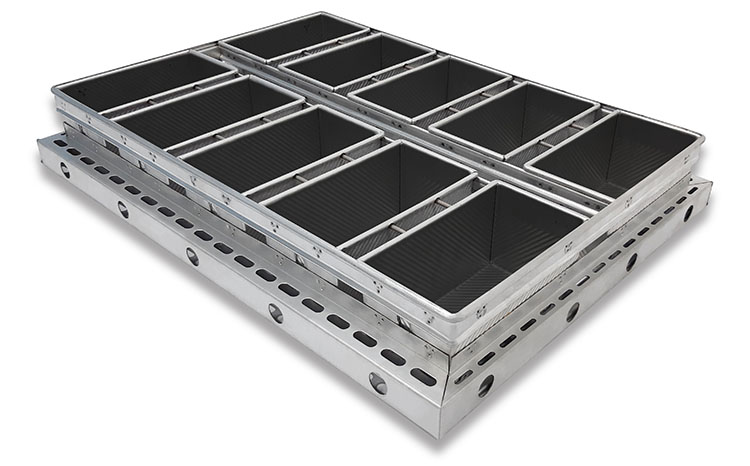
Having the right coating for the product, the process and the pan goes a long way to obtaining perfectly baked products for longer, while optimizing costs.
The durability of pan coatings starts the moment they meet the pan, and the design of the pan plays a major role in the life of the coating.
That is why American Pan considers the type of pan coating that will be applied from the very beginning of the bakeware design process. One of the main goals is to ensure that coated surfaces will not come into contact with other pan metal when travelling through the bakery or when pans are stacked.
The company has developed unique stacking designs for trays, tins, and lids, to avoid metal coming into contact with the coating, even if they are nested. “Having a proper stacking design not only ensures the ability to safely stack pans and save bakery space, it also protects the pan surface and coating, ensuring the maximum release life,” states Jesper Albertsen, Vice President of Sales for American Pan Europe.
One American Pan customer was using automated stacking which was causing damage to the coating and premature failure. Switching to a new stacking pan design allowed the customer to extend the coating life by approximately 30%.

© Bundy Baking Solutions
Proper use and care
Having a newly coated pan that matches the required specifications is the beginning of the road for the lifespan of that coating. Coatings come in a wide range – for example, there are OptiShield® coatings are specifically formulated to handle sticky doughs such as pretzels, buns, or muffins, while other coatings, such as DuraShield®, can suit a broader range of standard products.
For OptiShield® and DuraShield®, the main coatings that American Pan delivers in Europe, utilization guidelines include handling, the use of release agents and toppings, depanning, and their passage through conveyors, proofers, and ovens. Stacking and cleaning guidelines are also provided. Both OptiShield® and DuraShield® coatings are designed with excellent non-stick properties and are corrosion-resistant. To minimize any damage, scratching and abrasion should be avoided. For example, pan indexers should not be allowed to come into contact with the coated surfaces, which would ultimately damage the coating. To avoid this issue, bakeries can add rubber padding to the pan indexing fingers. If the non-stick coating incurs deep scratches, the pan’s surface is subject to corrosion and problems with product release.
Albertsen emphasizes that, “If a bakery notices damage to their pans or coatings, they should contact our team right away so that we can help determine the cause of coating damage and suggest solutions. Our goal is to ensure the longest pan and release life possible.”
What is applied to the pan or product can also affect the life of the coating. Using release agents such as oil or grease can cause build-up on the pans and reduce the effectiveness of the coating. Toppings such as seeds and protein or egg wash can also affect the coating life. Bakers should ensure proper cleaning techniques are used to remove the toppings without damaging the pan surface.Oven temperature can also play a role in the longevity of coatings. Ovens operating at a high temperature can decrease coating life through a process called thermal degradation. One American Pan customer switched from a tin set made with standard aluminized steel using a fluoropolymer coating to a set made with American Pan’s proprietary ePAN® materials and DuraShield® coating and were able to decrease oven temperature by 30° C and achieve over 4,200 releases without the use of oil.
“We can help determine the cause of coating damage and suggest solutions. Our goal is to ensure the longest pan and release life possible.”
Jesper Albertsen, Vice President of Sales, American Pan Europe
Finding the right coating
Identifying the coating that will work best in each case starts with the product and the company’s prior experience with it. Flouropolymers such as DuraShield® and OptiShield® are the most requested coatings in Europe, while AMERICOAT® silicone glaze is also used, especially in the UK.
The key to providing the best coating, according to Albertsen, is working closely with customers to understand their requirements and their bakery process. The company technology experts will then work with suppliers to offer the best and most appropriate coating technology. For example, the company‘s OptiShield® Crumpet Ring coating was developed through this process and nearly doubled the release life for a customer.
As part of the recoating services, American Pan will provide pan straightening, in addition to stripping away the old coating, cleaning, and applying the new coating. When fluoropolymer coatings like DuraShield® and Optishield® are reaching the end of their life, the wear can advance fairly quickly, which is why it is important for bakeries to time refurbishing or reordering of pans well in advance. American Pan Europe has refurbishment locations in Spain, the UK, and Romania, so shipping times can vary according to the proximity to one of these centers.
Rubberized coatings are another popular option for bread and baguette pans, among other products, because this coating contributes to achieving a crusty product. American Pan offers FlexiCoat in this range, in addition to RilonElast via the Runex brand, which was acquired in Sweden last year.
The article is part of an extended feature, which was originally published in [BBI 4 – 2022]. Read the full article in the magazine:


